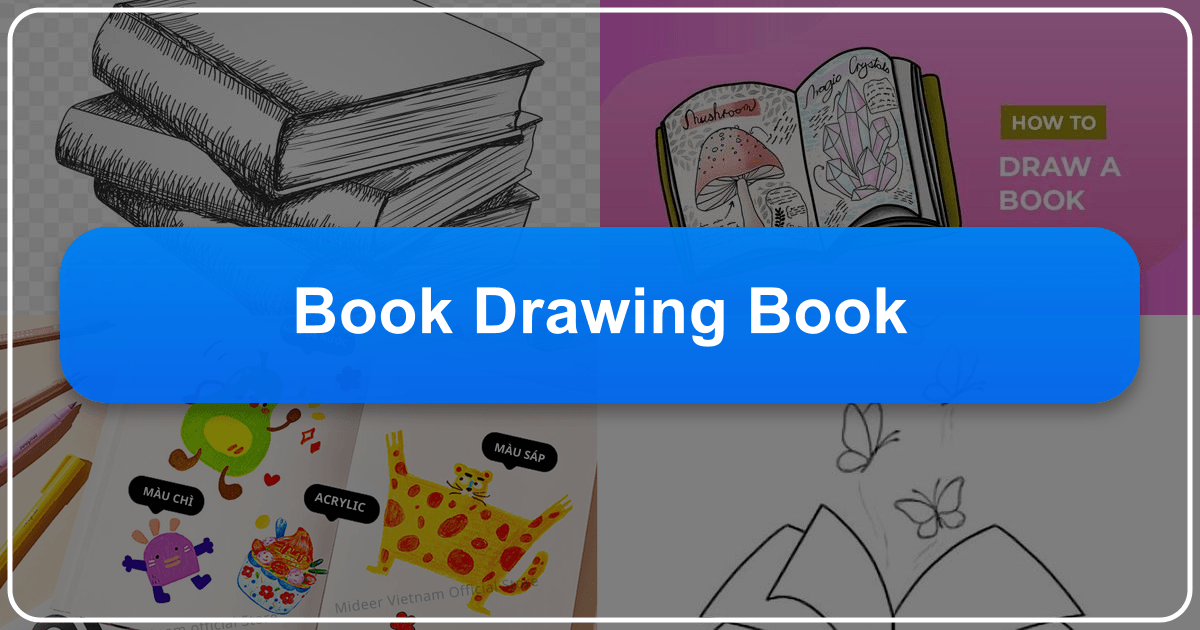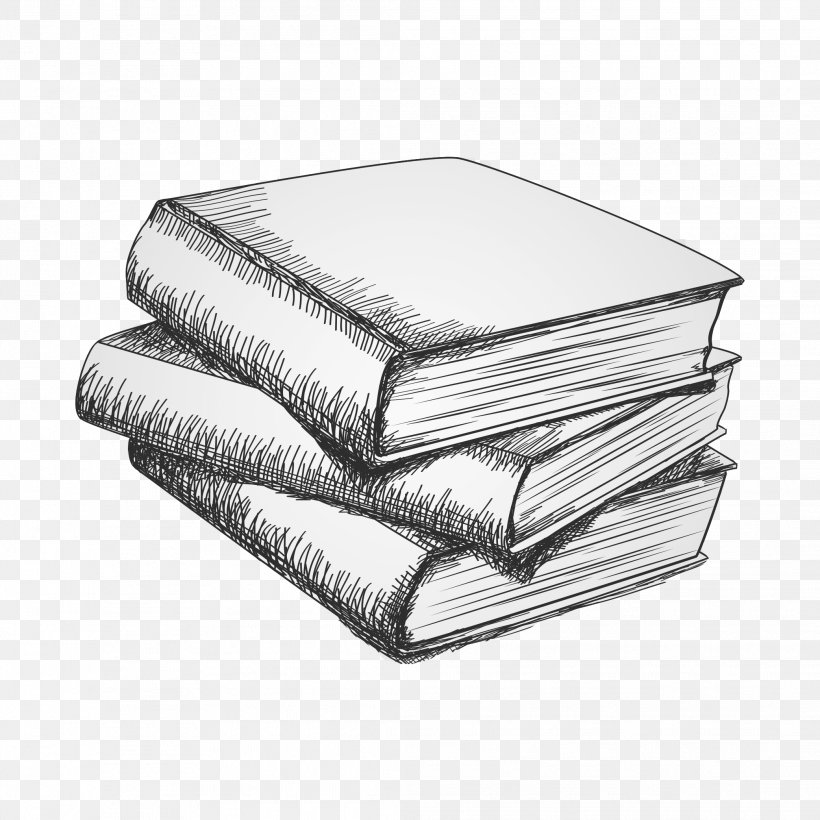Book Drawing Tutorial: A Comprehensive Guide

The seemingly simple act of drawing a book belies a surprisingly rich potential for artistic expression and technical skill development. From capturing the subtle curves of a well-worn spine to conveying the weight and texture of a stack of volumes, drawing books offers a rewarding challenge for artists of all levels. This comprehensive guide will explore various techniques and approaches to drawing books, catering to beginners and those seeking to refine their skills. We will journey through step-by-step tutorials, explore the nuances of perspective and shading, and delve into the broader cultural significance of books as objects of art and storytelling.
I. Drawing a Single Book: Mastering the Basics

The foundation of any successful book drawing lies in understanding its fundamental shape and form. Let’s start with the simplest representation – a single closed book. Several approaches exist, each providing a unique aesthetic:
A. The Geometric Approach
This method utilizes basic geometric shapes to construct the book’s form. Begin with a slightly elongated rectangle to represent the book’s cover. Add another, narrower rectangle to represent the spine, overlapping the first. Finally, draw a smaller rectangle at the bottom to represent the back cover. Observe how the edges of the rectangles intersect to create depth. This foundational step allows for accurate proportional construction. Remember that all elements should subtly reflect perspective and viewpoint.

Step-by-Step:
- Rectangle 1 (Cover): Draw a slightly elongated rectangle tilted slightly away to give a sense of perspective. The top edge should be shorter than the bottom.
- Rectangle 2 (Spine): Draw a narrower, slightly shorter rectangle representing the book spine, overlapping Rectangle 1.
- Rectangle 3 (Back Cover): Draw a smaller rectangle at the bottom of the spine, aligning it to maintain perspective. This will be the back cover.
- Refinement: Carefully erase intersecting lines to refine the shape. Add subtle rounded corners to represent the edges of the book.
- Shading: Apply shading to create depth. A darker tone along one side suggests a light source, enhancing the three-dimensionality of the book.
B. The Organic Approach

In contrast to the geometric method, this technique focuses on capturing the organic curves and subtle imperfections often found in real-world books. Start by sketching the general form lightly, paying close attention to the gentle curves of the spine and the slight rounding at the corners. Instead of strictly geometric shapes, rely on flowing lines and observations of how light interacts with the surface.
Step-by-Step:
- Light Sketch: Begin with a light sketch of the overall shape, focusing on the rounded corners and the subtle curve of the spine.
- Spine Detail: Pay extra attention to the spine; adding slight indentations or textures might enhance realism.
- Page Hints: Suggest the presence of pages by drawing slight subtle shading or lines near the spine.
- Refinement: Refine the lines, ensuring a smooth, natural transition from the cover to the spine and to the back cover.
- Shading: Use shading to illustrate folds, texture, and light reflections for enhanced realism.
II. Drawing Multiple Books: Perspective and Composition
Drawing a stack of books introduces the complexities of perspective and composition. The key is to understand how the size and shape of each book subtly change as they recede into the background. This demands attention to the principles of linear perspective—a process where parallel lines seem to converge as they extend away from the viewer.
A. Step-by-Step Approach for a Stack of Books:
- Base Book: Start by drawing the bottom book. Because it’s closest, it can be drawn with a more accurate representation.
- Subsequent Books: Gradually reduce the size of subsequent books as they move further back.
- Overlapping: Allow the books to overlap naturally, showing parts of one book disappearing behind the other.
- Perspective Lines: Imagine lines extending from each book’s corners, converging at a vanishing point to emphasize the depth. These lines provide the foundation for accurate perspective.
- Spine Variations: Consider adding slight variations to the spines; this could enhance realism. Some books might be thicker or more worn than others.
- Shading and Texture: Use shading to create depth and volume for each book, suggesting various textures like rough or smooth covers.
III. Drawing an Open Book: Perspective and Details
Drawing an open book adds a new layer of complexity, requiring a solid grasp of perspective and the ability to capture the delicate interplay of pages. The approach to this can be based upon what style you want to present, though the core principles remain largely consistent.
A. Step-by-Step Approach for an Open Book:
- Initial Shapes: Begin by sketching the basic shape of the open book. This can be done by using a combination of curved lines to define the pages and straight lines to represent the covers.
- Page Detail: Using very light strokes, indicate individual pages within the book to show the depth and bulk of the pages within.
- Page Curves: Consider the way the pages curve and fold, adding realistic details to make it appear more natural.
- Cover Depth: Add depth to the covers, as they often have some thickness.
- Perspective: Pay attention to the perspective of the open book, ensuring the parts of the pages closer to the viewer appear larger.
- Shading and Texture: Use shading to enhance the three-dimensionality, highlighting the curves and folds of the pages. Add texture to the covers, showing worn or smooth textures.
IV. Beyond the Basics: Adding Details and Style
Once you’ve mastered the fundamentals of drawing a book, you can explore various techniques to add intricate details and stylistic elements.
A. Adding Texture and Detail
Introduce texture to the book’s surfaces. The cover might show the grain of the paper or the subtle wear of usage. The pages can convey crispness or age and discoloration.
B. Incorporating Color and Tone
Experiment with color to capture the hues and shades of various book covers. Use color pencils, watercolors, or even digital painting tools to create dynamic and eye-catching artwork.
C. Creating a Narrative
A drawn book can become the centerpiece of a larger composition. You might incorporate it into a setting, illustrating a reading nook, a library shelf, or even a whimsical scene where the book comes alive.
V. The Cultural Significance of the Drawn Book
The book, as an object, holds immense cultural significance. It represents knowledge, storytelling, imagination, and the power of the written word. Drawing a book isn’t merely a technical exercise; it’s a way to engage with this powerful symbol.
A. Books as Objects of Art
The book’s physical form can be as compelling as its contents. From the elegance of a leather-bound classic to the vibrant colors of a modern paperback, books possess aesthetic qualities that artists can effectively translate onto paper.
B. Books in Popular Culture
Books frequently feature in literature, film, and art, symbolizing learning, mystery, or escape. Depicting a book in your artwork can subtly evoke these themes.
C. Books and Personal Expression
Drawing books can be a personal journey. The choice of style, detail, and composition reflects the artist’s unique perspective and interpretation of this powerful object.
By exploring these techniques and understanding the symbolism embedded within the object, you can create compelling and meaningful book drawings that resonate with both technical skill and cultural understanding. The journey of learning how to draw a book is a continuous process of observation, experimentation, and creative expression. So pick up your pencils, observe the world around you, and allow your imagination to guide you in capturing the beauty and essence of the drawn book.